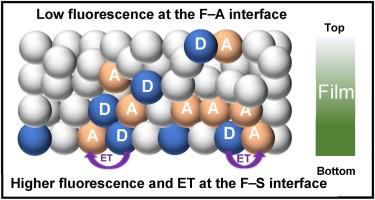当前位置:
X-MOL 学术
›
Chem. Eng. J.
›
论文详情
Our official English website, www.x-mol.net, welcomes your
feedback! (Note: you will need to create a separate account there.)
Stratification of polyisocyanate in two-component waterborne polyurethane films
Chemical Engineering Journal ( IF 13.3 ) Pub Date : 2024-01-22 , DOI: 10.1016/j.cej.2024.148981 Yang Liu , Kenneth Tran , Kevin Ho , Tianjia Yang , Xiaochong Li , Sze Hang Wong , Margaret Zhang , Gilbert Walker , Frédéric Lucas , Mitchell A. Winnik
Chemical Engineering Journal ( IF 13.3 ) Pub Date : 2024-01-22 , DOI: 10.1016/j.cej.2024.148981 Yang Liu , Kenneth Tran , Kevin Ho , Tianjia Yang , Xiaochong Li , Sze Hang Wong , Margaret Zhang , Gilbert Walker , Frédéric Lucas , Mitchell A. Winnik

|
The coatings industry continually seeks advancements in waterborne two-component polyurethane (2 K WBPU) systems, given their potential for environmentally friendly applications and superior film properties. This study explores the mechanistic aspects of film formation in 2 K WBPU coatings formulated with an acrylic polyol and a polyisocyanate (PIC) derived from a trimer of hexamethylene diisocyanate (HDI-trimer). To enhance water dispersibility—a key parameter in industrial applications—the HDI-trimer is modified with a short polyethylene glycol, producing a hydrophilically modified PIC (hmPIC). While prior studies identified hmPIC as an effective reactive plasticizer for the polyol, the common practice of adding unmodified HDI-trimer (uPIC) to hmPIC for moisture sensitivity reduction necessitates a deeper understanding of film properties. Using fluorescence resonance energy transfer (FRET) and confocal fluorescence microscopy, we investigated the effects of blending uPIC with hmPIC on coalescence, phase separation, and film stratification in 2 K WBPU systems. Notably, environmental factors like relative humidity were found to influence film stratification significantly. This finding has critical implications for coating performance, such as durability and water resistance. A novel method was also introduced to monitor water permeation within stratified films, offering a valuable tool for optimizing film properties in real-world applications. This study underscores the importance of strategic component interactions in polymer coatings, suggesting that controlled film stratification can significantly enhance film performance in industrial settings.
中文翻译:

双组分水性聚氨酯薄膜中多异氰酸酯的分层
鉴于水性双组分聚氨酯 (2 K WBPU) 系统在环保应用方面的潜力和卓越的涂膜性能,涂料行业不断寻求其进步。本研究探讨了由丙烯酸多元醇和衍生自六亚甲基二异氰酸酯三聚体(HDI-三聚体)的多异氰酸酯(PIC)配制的 2 K WBPU 涂料中成膜的机理。为了增强水分散性(工业应用中的一个关键参数),HDI 三聚体用短聚乙二醇进行改性,产生亲水改性的 PIC (hmPIC)。虽然之前的研究确定 hmPIC 是一种有效的多元醇反应性增塑剂,但在 hmPIC 中添加未改性的 HDI 三聚体 (uPIC) 以降低湿度敏感性的常见做法需要更深入地了解薄膜特性。使用荧光共振能量转移 (FRET) 和共焦荧光显微镜,我们研究了 uPIC 与 hmPIC 混合对 2 K WBPU 系统中聚结、相分离和薄膜分层的影响。值得注意的是,人们发现相对湿度等环境因素会显着影响薄膜分层。这一发现对涂层性能(例如耐久性和耐水性)具有重要影响。还引入了一种监测分层薄膜内水渗透的新方法,为优化实际应用中的薄膜性能提供了宝贵的工具。这项研究强调了聚合物涂层中战略成分相互作用的重要性,表明受控的薄膜分层可以显着提高工业环境中的薄膜性能。
更新日期:2024-01-22
中文翻译:

双组分水性聚氨酯薄膜中多异氰酸酯的分层
鉴于水性双组分聚氨酯 (2 K WBPU) 系统在环保应用方面的潜力和卓越的涂膜性能,涂料行业不断寻求其进步。本研究探讨了由丙烯酸多元醇和衍生自六亚甲基二异氰酸酯三聚体(HDI-三聚体)的多异氰酸酯(PIC)配制的 2 K WBPU 涂料中成膜的机理。为了增强水分散性(工业应用中的一个关键参数),HDI 三聚体用短聚乙二醇进行改性,产生亲水改性的 PIC (hmPIC)。虽然之前的研究确定 hmPIC 是一种有效的多元醇反应性增塑剂,但在 hmPIC 中添加未改性的 HDI 三聚体 (uPIC) 以降低湿度敏感性的常见做法需要更深入地了解薄膜特性。使用荧光共振能量转移 (FRET) 和共焦荧光显微镜,我们研究了 uPIC 与 hmPIC 混合对 2 K WBPU 系统中聚结、相分离和薄膜分层的影响。值得注意的是,人们发现相对湿度等环境因素会显着影响薄膜分层。这一发现对涂层性能(例如耐久性和耐水性)具有重要影响。还引入了一种监测分层薄膜内水渗透的新方法,为优化实际应用中的薄膜性能提供了宝贵的工具。这项研究强调了聚合物涂层中战略成分相互作用的重要性,表明受控的薄膜分层可以显着提高工业环境中的薄膜性能。

































 京公网安备 11010802027423号
京公网安备 11010802027423号